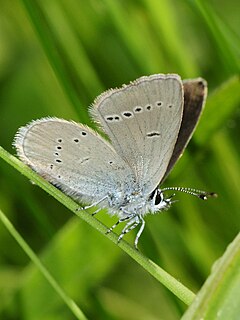
Millets are a group of highly variable small-seeded grasses, widely grown around the world as cereal crops or grains for fodder and human food.

Poaceae or Gramineae is a large and nearly ubiquitous family of monocotyledonous flowering plants known as grasses. It includes the cereal grasses, bamboos and the grasses of natural grassland and species cultivated in lawns and pasture. The latter are commonly referred to collectively as grass.

Cymbopogon, also known as lemongrass, barbed wire grass, silky heads, Cochin grass, Malabar grass, oily heads or fever grass, is a genus of Asian, African, Australian, and tropical island plants in the grass family. Some species are commonly cultivated as culinary and medicinal herbs because of their scent, resembling that of lemons . The name cymbopogon derives from the Greek words kymbe and pogon "which mean [that] in most species, the hairy spikelets project from boat-shaped spathes."

Buprestidae is a family of beetles known as jewel beetles or metallic wood-boring beetles because of their glossy iridescent colors. Larvae of this family are known as flatheaded borers. The family is among the largest of the beetles, with some 15,500 species known in 775 genera. In addition, almost 100 fossil species have been described.
Gangesha Upadhyaya was an Indian philosopher and mathematician from the kingdom of Mithila. He established the Navya-Nyāya school. His Tattvacintāmaṇi, also known as Pramāṇacintāmaṇi, is the basic text for all later developments. The logicians of this school were primarily interested in defining their terms and concepts related to non-binary logical categories.
PlatEAU is an electronic music project featuring cEvin Key and Phil Western. The project resembles a very loose approach to the Download project featuring the same members. The song names and album titles refer to the coffeeshop culture of Amsterdam in The Netherlands implying a "trip" through their musical voyages. The album art also reflects this concept with imagery on their first release on Hypnotic Records in 1997, Music for Grass Bars. This release had a special CD jewel case in order to create a holographic-motion effect with thecover art insert. The genre is most closely related to IDM, experimental, techno and trip hop.

Pennisetum is a widespread genus of plants in the grass family, native to tropical and warm temperate regions of the world. They are known commonly as fountaingrasses

The Iranian National Jewels, originally the Iranian Crown Jewels, include elaborate crowns, thirty tiaras, and numerous aigrettes, a dozen bejeweled swords and shields, a number of unset precious gems, numerous plates and other dining services cast in precious metals and encrusted with gems, and several other more unusual items collected or worn by the Persian monarchs from the 16th century and on. The collection is housed at The Treasury of National Jewels, situated inside the Central Bank of Iran on Tehran's Ferdowsi Avenue.

Heliotropium is a genus of flowering plants in the borage family, Boraginaceae. There are around 325 species in this almost cosmopolitan genus, which are commonly known as heliotropes. It is highly toxic for dogs and cats.

The Indian elephant is one of three extant recognised subspecies of the Asian elephant and native to mainland Asia.

Freyeria trochylus, the grass jewel, is a small butterfly found in Africa, Arabia, southern Europe, India and southern Asia that belongs to the lycaenids or blues family.

Chilades, commonly called jewel blues, is a genus of butterflies in the family Lycaenidae. The species of this genus are found in the Old World and in Australia.

Surendra quercetorum, the common acacia blue, is a species of lycaenid or blue butterfly found in the Indomalayan realm(in Simla Hills - Assam, Burma, South Bihaar, China, Vietnam).

Ludwig Georg Courvoisier was a surgeon from Basel, Switzerland. He was one of the first doctors to remove gallstones from the common bile duct.

Indigofera australis, the Australian indigo or Austral indigo, is an attractive species of leguminous shrub in the genus Indigofera. The genus name Indigofera is Neo-Latin for "bearing Indigo". Australis, from the Latin, means not “Australian” but "southern", referring to the geographical distribution of the species.

The Osiris blue is a butterfly in the family Lycaenidae. It is found in South Europe, Asia Minor, southern Siberia, the Alay Mountains, Tian-Shan, Dzhungarsky Alatau, the Altai Region, the Sayan mountains, Lake Baikal and Mongolia. It is often confused with the small blue, a closely related species.

Freyeria putli, the eastern grass jewel or small grass jewel, or oriental grass jewel is a small butterfly found in Ceylon, India and Australia that belongs to the lycaenids or blues family.















